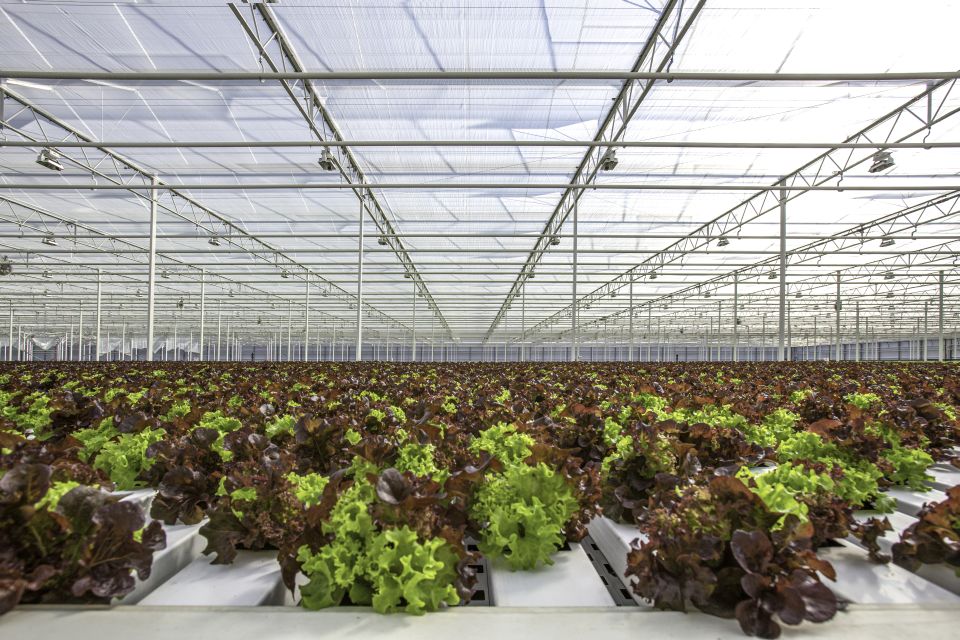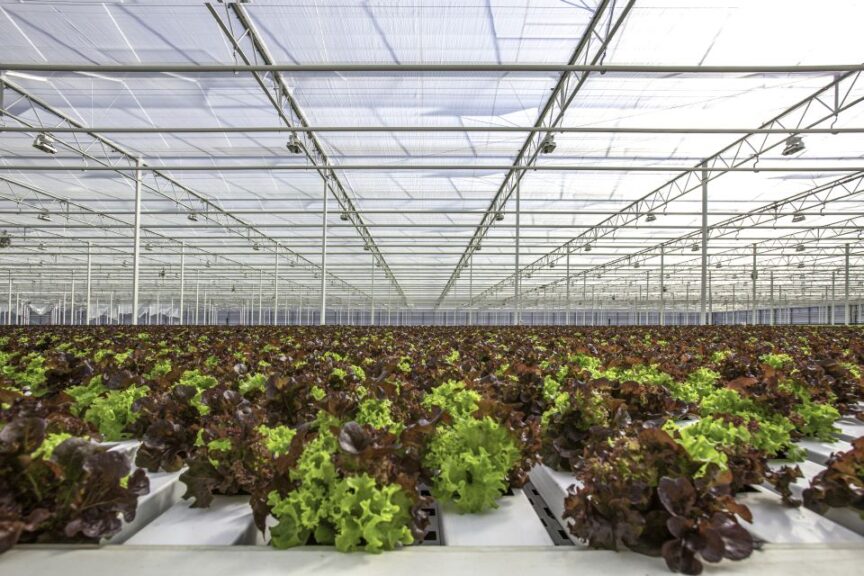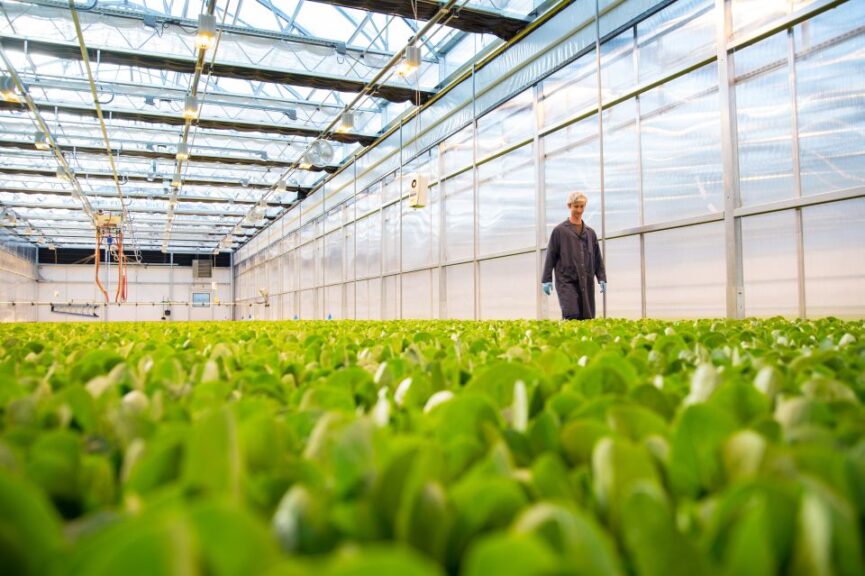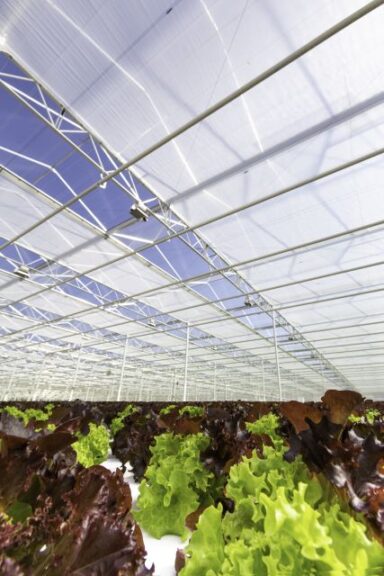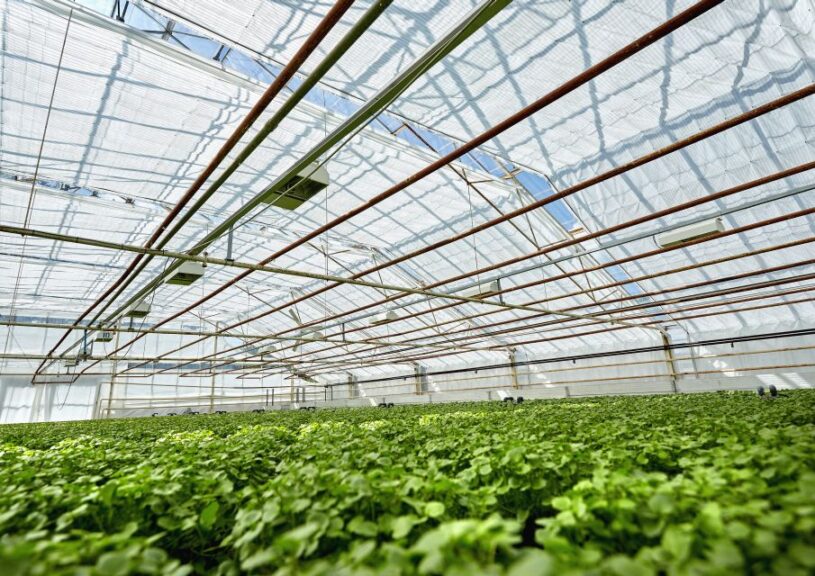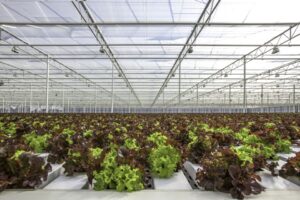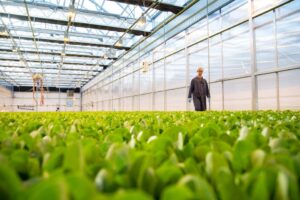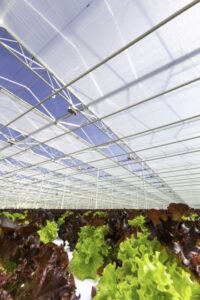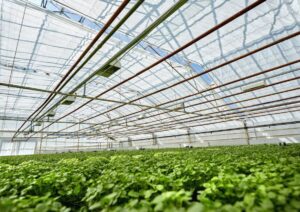The Story Behind Greenhouse Curtains
Many greenhouse growers are investing in greenhouse structures, coverings, and internal equipment like shade and thermal curtains (also referred to as climate screens). Considering the diverse benefits for operations in any climate zone, curtain systems are a key tool for greenhouses and growers across the world. To enhance competitive advantage, facility resilience, and crop production, thoughtfully choose and operate greenhouse curtains using best practices shared from controlled environment agriculture industry experts.
Curtains come in many kinds: thermal, diffusion, shade, light abatement, and blackout are all terms that refer to benefits to plants and facilities. Growers can reduce thermal losses, lessen the intensity of sunlight with diffusion, shade plants, and prevent light pollution. Curtain systems offer non-energy benefits like increased crop growth, lower costs, and can be a pathway for compliance with light pollution regulations. Growers can use multiple different screens to optimize greenhouse climates and have a positive impact on crops by increasing quality and shelf life, reduce operating expenses from energy, and mitigate light leaks.
Choosing Curtain Types
The curtain system most suitable for a greenhouse depends on the curtain’s purpose. Growers may use two or more screens in the same cultivation space for more insulation or to mix and match different types of screens to improve climate control, improve crop quality and yields, and reduce light pollution.
Heat is constantly exchanged between the inside and outside of a greenhouse. Thermal curtains (or energy-saving curtains) are closed-knit or close-weave fabrics that limit heat transfer with the outdoors and retain desired heat at night and during winter days, while also preventing unwanted heat gains from the sun if used for shading during summer days. Thermal curtains may be transparent to allow maximum light transmission for winter days, or have shading properties to help cool the crop and prevent excessive light saturation in summer. Transparent thermal curtains are often used with vegetable crops in northern climates, while thermal curtains with moderate to high shade value are used for ornamentals and lettuce in moderate and warm climates.
Thermal curtains help growers maintain proper environmental conditions and avoid humidity swings. Even if you maintain your relative humidity levels, condensation can form on your roof, walls, and frame when it is cold outdoors due to the low dew point of the air. Water dripping on crops can increase the risk of disease. Thermal screens also serve as a protective barrier over plants if condensation occurs and drips from the roof. Thermal curtains, particularly knitted ones, also transport humidity across their structure, helping to stabilize humidity in the greenhouse space and prevent large humidity swings.
Resource Innovation Institute Facility Design & Construction Working Group member Ludvig Svensson manufactures a diverse array of curtain types.
“Modern thermal curtains that provide shade also provide light diffusion, which improves uniformity of light distribution in the greenhouse, helping to minimize shadows on the crop and reduce crop temperature,” says climate consultant Rob Hanifin. “In addition, light-diffusing shade curtains may also be of open structure, with gaps in the knit or weave that freely allow airflow. These are of tremendous advantage for growers seeking to combine use of shade and diffusion curtains with ventilation through roof vents to cool the greenhouse during the warmer months.”
Many greenhouse growers use supplemental lighting systems to extend crop photoperiod after dark, especially during shorter winter days. However, with more greenhouses doing this than ever before, considerable light pollution can be an unwanted result. Light pollution can have negative environmental and cultural impacts, and as a result local governments have taken steps to mitigate light pollution in some regions using policy solutions restricting the light emissions from greenhouses. The easiest approach to minimize light pollution from greenhouses is to use blackout curtain systems.
“With blackout screens, we can use the optimal lighting schedule for our crops without worrying about light pollution regulations no matter where we are located,” notes Jose “Pepe” Calderon of Local Bounti.
Specific blackout screens for light abatement are typically single layer curtains that block up to 99% of light from leaving the greenhouse. These curtains offer similar energy savings as the thermal curtains touched on before, as well as help to mitigate humidity build-up. They also differ from the multilayer blackout curtains used to create short days for photo-sensitive crops, which reduce light by at least 99.9%. These blackout screens offer greater energy savings, but are typically restricted in their hours of use.
Control Greenhouse Environments
The largest advantage of thermal curtains is energy efficiency, which often provides a return on investment of one to four years depending on the greenhouse location and how many hours the curtains are in use. RII producer partner Local Bounti grows food year-round using greenhouse curtains in Montana and California and uses curtain systems to maintain target daily light integral (DLI) for crops, keep light in the greenhouse, and save energy on heating and cooling.
“Energy is a high expense in a greenhouse. Most of our energy is spent attempting to maintain a decent temperature for our lettuce crops. Energy screens are essential for retaining heat and achieving optimal greenhouse environment conditions,” shares Calderon, Local Bounti’s head grower. In greenhouses, energy used for heating and cooling can be the primary contributor to energy costs, and climate curtains are effective tools to reduce the electricity used for cooling and fuels like natural gas and propane consumed for heating that drive operating costs of greenhouses.
During cold weather, curtains reduce heating demand by preventing heat loss through greenhouse covers or glazing. This is true not only in chilly climates or throughout the winter, but also at night, even in warm climates that experience temperature dips at night. Up to 80% of the heating demand on a greenhouse may be during the night. When it is warmer, curtains offer shading and light diffusion in the summer months to reduce cooling loads and to keep crop temperatures lower. No matter what system you use, one thing is certain: as the costs of energy change, most rates increase over time, so minimizing energy consumption increases business profitability.
Two-curtain systems in greenhouses have the potential to help the grower further reduce energy consumption, as well as gain greater control over their greenhouse climate. The greater cost of installation of two thermal curtains is often made up for by the gains in energy-savings achieved, especially in colder climates. The two curtains can be deployed together at night, and as needed during the day, to maximize energy savings. The second thermal curtain may also serve an additional purpose, such as being a light abatement blackout curtain.
Access Financial Incentives
Utilities all over the U.S. and Canada are getting involved with greenhouses and their energy use. Gas and electric utilities can help the grower calculate their proposed energy reduction while also providing rebates for new, efficient screens. Some utilities do not have adequate staff, knowledge, or resources to operate complicated controlled environment agriculture (CEA) rebates. RII Utility Working Group member Evergreen Consulting Group improves efficiency programs for growers by providing specialized CEA utility consulting to research, design, and implementation of greenhouse rebates on behalf of utilities.
“Curtains are one of the best energy efficiency measures that we support in greenhouses across North America,” shares Lauren Morlino, Technical Manager for the Evergreen Consulting Group. “Heating costs can be reduced up to 50% in cold climates, depending on the type of screens used. Although energy screens are beneficial to most growers, the upfront cost for screens can be prohibitive.”
That is where utility rebates come in. Growers can receive financial and technical assistance, while utility and efficiency programs reach energy savings goals. Additionally, heating energy saved from fossil fuels like gas or propane reduces the carbon footprint of grower businesses. Rebates can often make a difference of whether or not a grower can move forward with the addition of curtains in a greenhouse. Greenhouse rebates are a win-win-win for growers, utilities, and the environment.
“For growers, the best thing to do is first look for commercial or agriculture rebates on utility websites and search for greenhouse offerings. If online rebates are not found, call the utility and ask about rebates for greenhouse technologies like thermal curtains. Incentives may be custom or not advertised widely,” shares Morlino.




